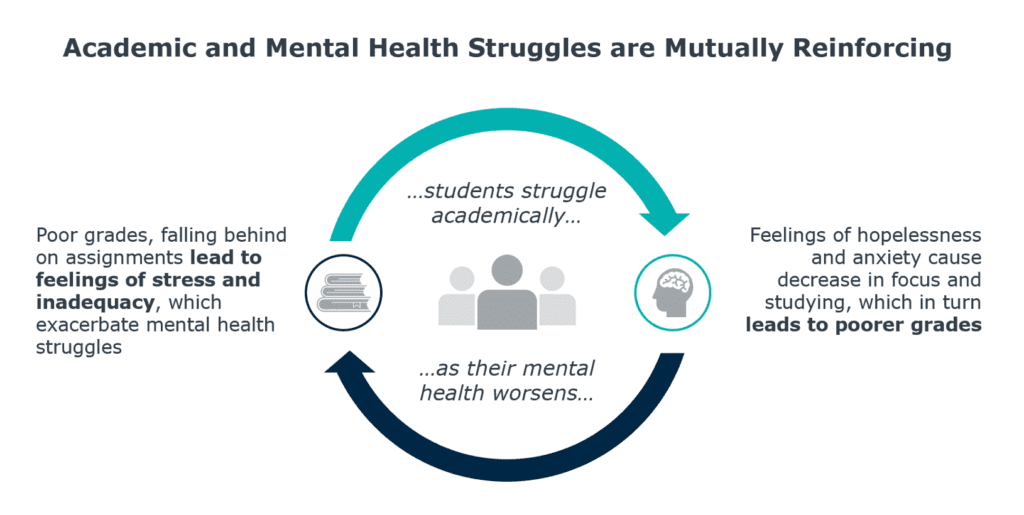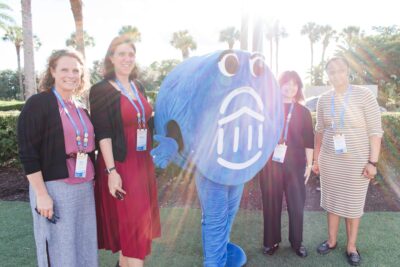Student readiness is this generation’s defining challenge. Solving it will require true collaboration.
At EAB, our partnerships with thousands of K-12 schools, community colleges, four-year universities, and employers give us unique insight into the progress and outcomes of each generation of students. Recently, colleagues across EAB (me included) have become increasingly concerned about what we perceive to be this decade’s (and perhaps this generation’s) defining challenge: academic and socioemotional readiness in the wake of the COVID-19 pandemic.
Today…
- Thirty-three percent of K-12 students are chronically absent.
- Forty-two percent of ACT-takers met none of the college-readiness benchmarks in English, reading, science, and math.
- Forty-two percent of high school students report feeling persistently sad or hopeless, 1.5x higher than just a decade ago.
This is just a smattering of the data that illustrates this growing challenge. If left unaddressed, these student readiness gaps could lead to further declines in college enrollment rates and exacerbate skills gaps in the workforce. Read on for research and insight into the student readiness crisis across K-12 schools, college and university campuses, and the workforce—and how these sectors can come together to address readiness gaps.
What is “the student readiness crisis”?
We define readiness as each student having the knowledge, skills, and support needed to access and succeed in college, career, and life. Helping today’s students achieve this “readiness” will require working together across sectors to overcome academic, socioemotional, financial, and career preparedness gaps exacerbated by the disruptions of the pandemic.
The exacerbating effect of mental health challenges
Academic and socioemotional readiness are two of the most significant predictors of whether students will attend college, complete their degree, and thrive in the workforce. But students across all grade levels find themselves trapped in a vicious cycle, where academic and mental health struggles compound one another. Students are struggling to grasp new concepts, cope with stressors, and build the confidence needed to shape their collegiate and career paths.

Unfortunately, the most significant impacts of the pandemic are still ahead of us. Students who were in elementary school when the pandemic began are not likely to fully recover academically by the time they reach college in the next three to five years—meaning student readiness trends are expected to get worse before they get better.
What does this crisis mean for K-12?
Despite the hard work of teachers, schools, and districts, academic attainment gaps persist. At the beginning of the 2022–23 school year, public schools reported that 50% of their students were behind grade level, up from 36% prior to the pandemic. Chronic absenteeism—defined as missing at least 10% of the school year—has further disrupted continuity of instruction in foundational areas like reading and math and only exacerbated the number of students missing key benchmarks.
Absences have also exacerbated socioemotional challenges. Many of the skills needed to navigate social relationships and develop a strong sense of self are built through face-to-face play during lunchtime with peers and extracurricular activities—most of which were unavailable during the pandemic. For students looking toward college, this anxiety and stress can overshadow their college search and planning. Nearly half of high school students in our recent poll reported that anxiety, nerves, and worry hindered their college search process.
What does this crisis mean for higher ed?
Given the challenges in K-12, it’s no surprise that students are increasingly arriving at college lacking essential reading, writing, and math skills. Beyond basic skill gaps, faculty are seeing a growing number of students who struggle to attend class, stay focused, and complete assignments on time. These trends also permeate graduate programs, where students’ writing skills often do not meet faculty expectations and more students are seeking tutoring than in years past.
During the pandemic, students missed opportunities to develop the social skills and emotional resilience to navigate new experiences, build friendships, and manage the rigors of college life. As these students matriculate, student affairs staff are seeing a greater and often untenable demand on counseling, academic resource centers, and disability service as students find themselves being overwhelmed by academic expectations, struggling with executive function skills (such as time management and problem-solving), and having trouble navigating interpersonal relationships.
It seems like every day there is a student in one of our offices that’s in some version of crisis.
VP student success
Community College in the Midwest
These socioemotional and academic gaps are leading more students to opt out of higher ed all together, worsening a nonconsumption problem that has become all too familiar to enrollment leaders. In our survey of nearly 6,000 high school students, about one-third said that mental health concerns threaten to delay their decision to attend college or may lead them to forgo college entirely.
What does this crisis mean for employers?
One of the purposes of education is, of course, to equip students with the skills needed to enter and succeed in the workforce. But students and employers alike report that readiness gaps have translated to gaps in professional skills. About 40% of recent college grads said their education did not prepare them for the difficulties of transitioning into the workforce. And employers shared that new professionals are struggling with a host of socioemotional and professional skills, including the ability to communicate effectively with supervisors and leadership, solve problems independently, understand workplace boundaries, collaborate with colleagues, and give and receive constructive feedback. On a macro level, a less prepared workforce may struggle to innovate, ultimately hindering economic growth and progress.
Explore resources for talent and HR professionals
How will we solve it?
As our researchers began to explore what post-pandemic readiness gaps mean for students, it quickly became clear that addressing these challenges will require a different-in-kind approach. The far-reaching impacts of the student readiness crisis, from college to career to life, mean that K-12, higher ed, and employers must work together to confront these critical gaps.
For that reason, our EAB and Seramount teams are launching an initiative that unites education and the workforce to address the student readiness crisis. Our goal is to make a meaningful and measurable difference in closing student readiness gaps by providing freely accessible research and guidance for educators and employers and by creating opportunities for leaders across these sectors to come together.
Because both EAB and Seramount are rooted in best practice research, the logical first step in this work was to aggregate our insights on this topic. I hope you’ll explore the blog posts, toolkits, podcasts, and more on our (regularly updated) resource center, as well as the research and recommendations for education and employers in our new insight paper.
The second step is to build broader awareness of and urgency around closing readiness gaps. On October 23, we’re hosting a webinar that will bring K-12, higher ed, and employers together for a discussion of the student readiness crisis and how we can unite across sectors to address it.
Historically we would expect that your first two years on the job would be spent learning skills, and not necessarily contributing to productivity. Now, we need to partner with education to teach those specialized skills so the on-ramp to productivity happens faster.
Jeremy Broome
Global Head of Talent, Visa
This initiative is just one part of our ongoing work to make education smarter and our communities stronger. In this post-pandemic moment, when readiness gaps are wider than ever, this work assumes an even greater urgency. With swift and deliberate action, we can help millions of students reach milestones, foster lifelong connections to education, and set the course for fulfilling careers. Our EAB and Seramount teams remain committed to studying this problem and providing the technology, insight, and research needed to bridge these gaps and prepare generations of learners for a brighter future.

More Blogs

Four signs it’s time to break up with your student CRM

Three lessons from 1,200 student success leaders on higher ed’s future
